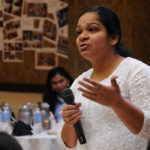Republished with permission by Vista, see original article here
Photo by Adrian Dascal on Unsplash
In what ways do you or your agency/church make a distinct contribution in outlining a vision or addressing a challenge for mission in Europe?
In answering this question, respondents demonstrated a wide range of approaches and contributions to mission in Europe. Some saw one of their key contributions as being an ability to draw people together, such as “a yearly conference gathering leaders from across the continent” (Daniel Costanza of PEF) or “a think tank of national leaders,” as reported by Raphael Anzenberger, whose organization already draws in leaders from 16 European countries who discuss mission strategy together (more information is at nc2p.org).
The European Evangelical Alliance’s Frank Hinkelmann explained how the EEA’s unique contribution was equipping national Evangelical Alliances and helping them “establish networks and special interest groups within their countries to reach out to their fellow countrymen.” Others echoed this emphasis on equipping people to work within their own culture – for example the European Baptist Foundation has empowered some 250 people to plant churches in their own culture, and the EBF’s role is to provide support for thisindigenous work. Approximately 15,000 new believers are reported to be the fruit of this initiative.
Others emphasized their role in creating partnerships – and were keen to stress the genuineness of such partnerships. John Gilberts of Greater Europe Mission described how they create church to church partnerships and, with 70 years’ experience, “have a unique role in effectively bringing US and Canadian churches together with some of the best on-the-ground ministries in Europe.” Key to this is GEM’s ability to “smooth intercultural issues and help both sides avoid the typical ‘bumps in the road’.” Representatives of migrant churches and diaspora movements also stressed the importance of relationships, specifically two-way and equal ones.
Samuel Cueva of the “Misión para el Tercer Milenio” Movement (MTM) explained their work to “develop two-way mission bridges for the fulfilment of God’s mission in all continents, and promotion of a theology of reciprocal mission collaboration.” This reciprocity was seen as essential and it was deemed necessary to be intentional about working towards it, as in the case of Latin American mission partners working with European mission partners in Europe, according to Cueva’s examples. With something of an outsider’s perspective on Europe, Jeff Carter also highlighted the importance of “filial respect” and “mutual support.”
Some specific examples were also given: Richard Bromley of ICS saw their distinct contribution as a “frontier agency” to be “always pushing… challenging the [Anglican] church to adapt and faithfully reach out to what is, not what was.” Dr Harvey Kwiyani, Programme Leader of MA African Christianity at Liverpool Hope University, explained how his focus is on providing cross-cultural training to diaspora Christians in the UK and across Europe. And Joke Haaijer of OneHope saw their distinctive as “activating churches for missions to children and youth.”
Overall, therefore, we see a wide range of contributions towards outlining a vision for mission in Europe, including facilitating, improving communication, equipping, partnering, challenging, training and mobilising.
The Vista Editorial Team is comprised of Darrell Jackson, Jim Memory, Jo Appleton, Chris Ducker, and Evert Van de Poll





